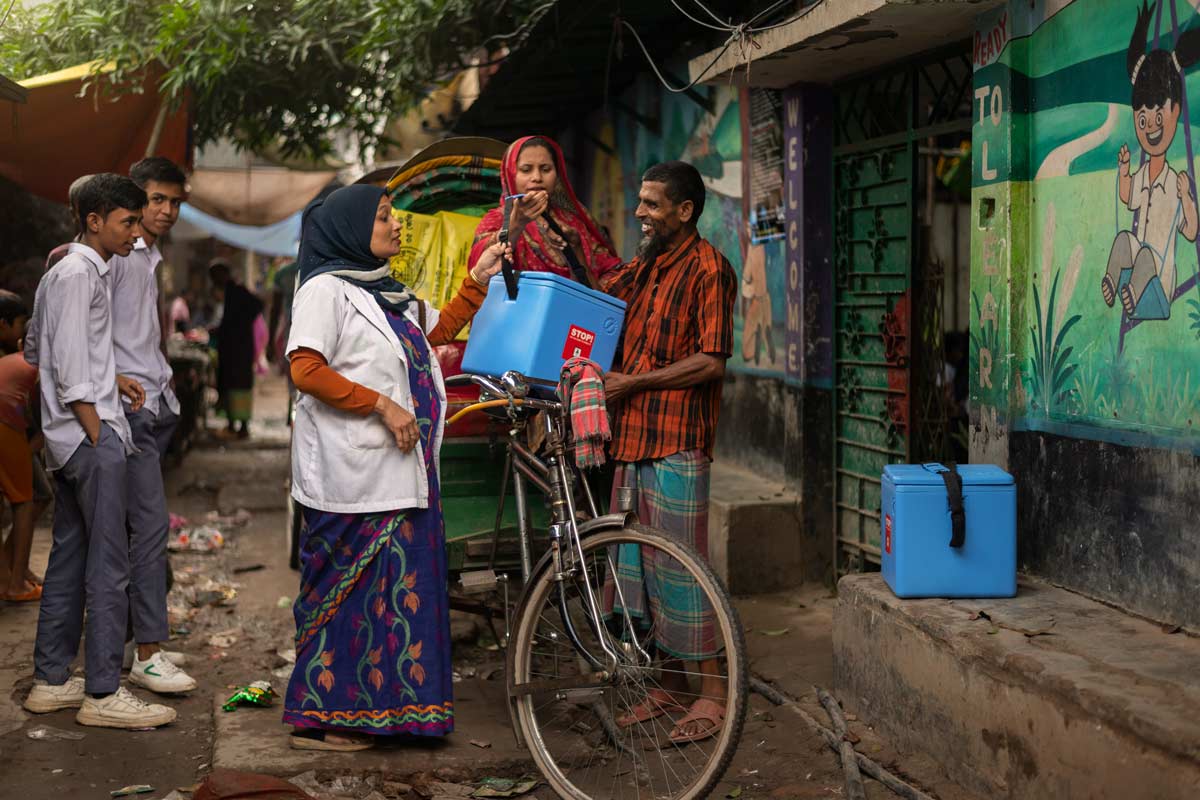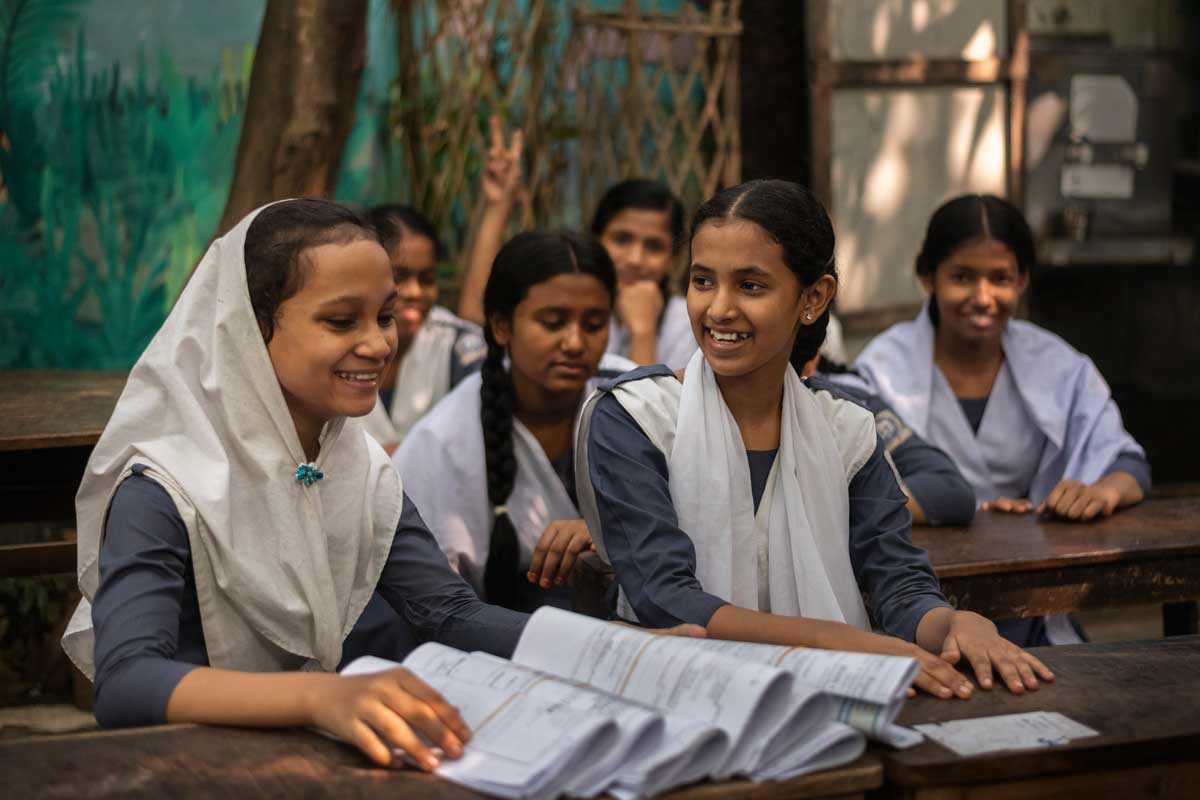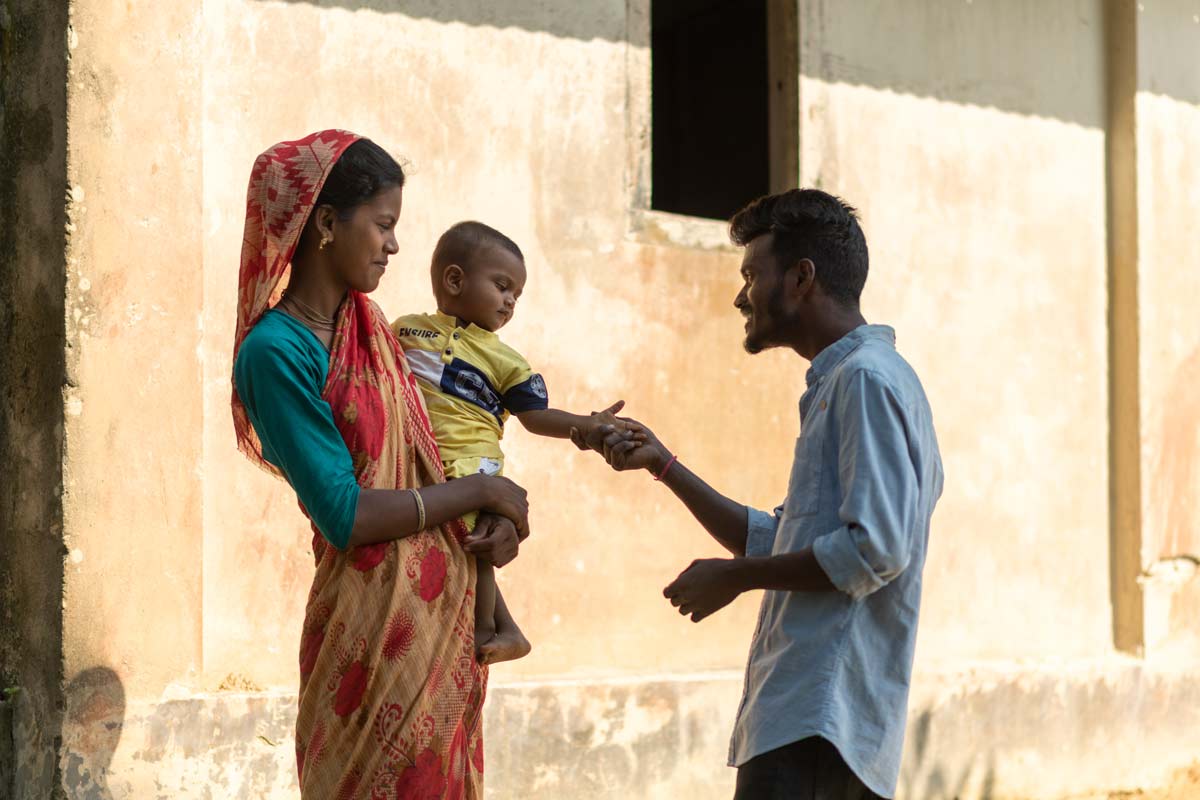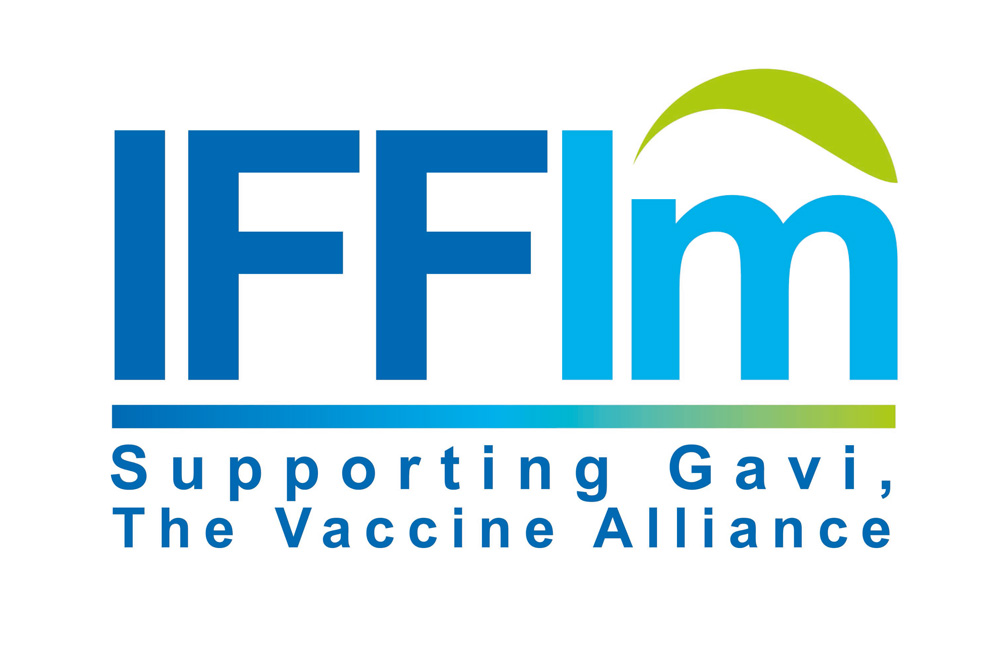50 years of progress: how Bangladesh chose health
- Impact
- 50 years of progress: how Bangladesh chose health
50 years of progress: how Bangladesh chose health
21 May 2025

A health worker in Bangladesh transporting vaccines in a cool box. Credit: Gavi/2023/Ashraful Arefin
Less than half a century after being labelled a “basketcase”, Bangladesh is on the way to independently financing its immunisation programme.
Less than half a century after being labelled a “basketcase”, Bangladesh is on the way to independently financing its immunisation programme.
by Mohammad Al Amin, Gavi Staff
Announcements
IFFIm impact: Bangladesh
US$ 135.5M of IFFIm funds (core and COVAX) have been used to fund programmes in Bangladesh since 2021.
In 1979, the year that Bangladesh launched its national immunisation programme, 211 out of every 1,000 children born within its borders were expected to die before their fifth birthday.
The country was young – just eight years had passed since the liberation war of 1971 – densely populated, and extremely poor. According to the World Bank’s 1979 World Development Report, a GNP per capita of US$ 901 meant few places2 were poorer. And the trend-line appeared to be moving in the wrong direction: for the period until 19773, the country’s average annual growth rate was in the negative. Disease rates were high, doctors and nurses were in staggeringly short supply4, and the average person could expect to live just 47 years.

Analysts and theorists of international development made Bangladesh their marginal case: if Bangladesh can, anywhere can. Henry Kissinger branded the country an “international basketcase”; in his 1984 book, influential Bangladeshi economist Rehman Sobhan5, would describe “a moribund economy hooked on the aid narcotic”.
Not half a century later, Bangladesh has outsprinted those descriptions. A child born in Bangladesh today can expect a far longer, safer life. The country’s under-five mortality rate now stands at 31 per 1,000 live births. Life expectancy has risen to 73.7 years – higher than both India’s and Pakistan’s. How that happened is a complicated story – Bangladesh’s development has been hyped by onlookers as an “economic miracle”, then, in turn, demoted by critics, to overhyped.
Two things are clear and important: Bangladesh has managed to become much richer, and has invested steadfastly in its population’s health. It’s doing so with increasing independence: year on year, Bangladesh is shouldering a greater share of the cost of vaccinating its children, and is on track to transition out of Gavi support by 2030.

Bangladesh bets on vaccines
According to Be-Nazir Ahmed, former Director of Disease Control at the Directorate General of Health Services (DGHS), vaccination rates at the end of the first decade of Bangladesh’s existence stood at about 2%.
Those days may seem now to belong to another epoch, but they were recent enough that Ahmed remembers the consequences of that yawning vulnerability – in fact, even when he took up his first post in the Expanded Programme on Immunization (EPI) in 1989, “the number of child mortality (below five years) was around 5 lakh [500,000] in a year.” About a third of those deaths were attributable to the six diseases targeted by the country’s vaccination programme at that time: measles, tuberculosis, polio, diphtheria, tetanus and pertussis, he said.
Ahmed retired from his DGHS job in 2018. By then, Bangladesh had achieved 98% coverage with the third dose of the basic diphtheria, tetanus and pertussis-containing vaccine (DTP3); measles coverage was, and remains, at 93%,and the country has been officially polio-free since 2014.
“The country’s escalation from its poor immunisation coverage was possible through various measures like advocacy, communication and social mobilisation engaging communities, political commitment and continued support of partners like Gavi,” said Ahmed. “Above all, the awareness of the parents – especially the mothers – has been the key impetus for raising and sustaining the high immunisation coverage of the EPI programme.”
The country’s immunisation programme continues to expand its arsenal of vaccines: in October 2023, Bangladesh launched the human papillomavirus (HPV) vaccine to protect girls from cervical cancer. Currently, EPI officials say they are preparing to introduce the typhoid conjugate vaccine (TCV) into the routine schedule with Gavi support and look forward to rolling out Japanese encephalitis vaccines in the near future.
“Our country has made remarkable progress over the last 20 years in terms of providing life-saving vaccines against deadly infectious diseases to its children and women, preventing thousands of deaths and thus significantly contributing to lowering the infant and women mortality and morbidities,” Dr S.M. Abdullah-Al-Murad, Line Director (Maternal and Child Health & Adolescent Health) of the DGHS told VaccinesWork.
That progress underpinned the country’s 2010 achievement of Millennium Development Goal 4 – reducing under-five mortality by two thirds, he said. Currently, he noted, the immunisation system is working on boosting vaccine coverage in harder-to-reach populations, including urban slums and industrial areas. “The programme is also keeping a close eye on its rural hard-to-reach areas,” he added – like the country’s hilly tracts, the remote regions of Char and Hoar, and among nomadic groups.

Towards immunisation self-sufficiency
Not only has Bangladesh proven itself far from a “basketcase,” its economy’s robust and sustained growth and the concomitant improvement in its human development indicators has qualified it for “graduation” from the UN’s list of “least developed countries” (LDCs) in 2026.
That anticipated shift in status reflects Bangladesh’s increasing self-sufficiency – a development that has been tracked by its evolving partnership with Gavi.
Gavi, established in 2000 to help get children in the poorest countries protected with vaccines, has been supporting immunisation in Bangladesh since 2001, when basic vaccine coverage in the country stood at 72%. But the Gavi model is designed to provide countries with a leg-up towards sustainable self-financing – so as countries get wealthier, they pay a greater proportion of their vaccine bill.
In 2020, Bangladesh was covering 39% of the US$ 160 million bill for protecting its women and children with vaccines. That percentage has been growing, even as the vaccine programme grows, too. The cost of Bangladesh’s immunisation programme totalled US$ 221 million in 2022, and is projected to reach US$ 382 million by 2030,6 by which year the country is set to transition from Gavi support altogether.
According to Nilgun Aydogan, Gavi’s Bangladesh team lead, Bangladesh’s mounting financial undertaking reflects a laudable political dedication to health. “From covering 39% of its vaccine costs in 2020, to fully owning its immunisation future by 2030, Bangladesh’s EPI journey is a testament to national commitment, resilience and the unwavering pursuit of health equity for women and children,” she said.
The road to fully self-financed vaccination programme will not be without its challenges. Recent political and economic upset in the country – longtime prime minister Sheikh Hasina was ousted in mid-2024 – are a reminder of that, but have not knocked Bangladesh’s transition trajectory off-course. However, Prof Dr Sayedur Rahman, who is serving as Special Assistant to the Chief Adviser in the interim government, told VaccinesWork that the Bangladeshi establishment is seeking further support from development partners.
“We have already asked for extension Gavi support,” he said. “But getting the extension depends on different factors. Even if we do not get the extension, there will be no problem as we have already started participation in financing. The amount of co-financing will increase in phases,” he said.
Gavi representatives, meanwhile, reference the country’s track record as grounds for optimism. “For decades, Bangladesh has shown unwavering political commitment to immunisation – transforming that dedication into tangible health gains for millions,” said team lead Aydogan. “As the country steadily advances towards full self-financing of its immunisation programme, we remain confident that this legacy of leadership and investment in public health will only grow stronger.”
1 Closer to US$ 396 in today’s money
2 Bhutan’s GDP per capita, at US$ 80, was lower; Cambodia lacked GDP data for the period on record. But where Bhutan and Cambodia had populations of 1.2 and 8.4 million respectively, Bangladesh was home to 81.2 million people within a significantly smaller area than Cambodia’s.
3 The World Development Report looks at the period 1960–1977, but Bangladesh was still East Pakistan for most of that period. The years between 1971 to 1977, however, saw more than enough serious economic challenges to the hatchling nation: rising inflation, a global oil price shock, a drop in foreign aid, natural disasters and famine, and in 1975, the assassination of Bangladesh’s founding president, Sheikh Mujibur Rahman.
4 In 1976, Bangladesh had a ratio of one doctor per 11,350 people, and one nurse per 53,700 people.
5 Sobhan was especially critical of political pressures levied by international donors.
6 Immunization investment case report for Bangladesh, Thinkwell for Gavi, the Vaccine Alliance, Feb 2024
 | This article is republished from VaccinesWork under a Creative Commons license. Read the original article. VaccinesWork is an award-winning digital platform hosted by Gavi, the Vaccine Alliance covering news, features and explainers from every corner of global health and immunisation. |
Share this article
Restricted Access Library
 The material in this Restricted Access Library is intended to be accessed only by persons with residence within the territory of a Member State of the European Union and is not intended to be viewed by any other persons. The material in this Restricted Access Library is provided by IFFIm for information purposes only and the materials contained herein were accurate only as of their respective dates. Certain information in the materials contained herein is not intended to be, and is not, current. IFFIm accepts no obligation to update any material contained herein.
The material in this Restricted Access Library is intended to be accessed only by persons with residence within the territory of a Member State of the European Union and is not intended to be viewed by any other persons. The material in this Restricted Access Library is provided by IFFIm for information purposes only and the materials contained herein were accurate only as of their respective dates. Certain information in the materials contained herein is not intended to be, and is not, current. IFFIm accepts no obligation to update any material contained herein.
Persons with residence outside the territory of a Member State of the European Union who have access to or consult any materials posted in this Restricted Access Library should refrain from any action in respect of the securities referred to in such materials and are otherwise required to comply with all applicable laws and regulations in their country of residence.
By clicking Access restricted content: DYNAMIC-LINK-TEXT I confirm that I have read and understood the foregoing and agree that I will be bound by the restrictions and conditions set forth on this page.
The materials in this Restricted Access Library are for distribution only to persons who are not a "retail client" within the meaning of section 761G of the Corporations Act 2001 of Australia and are also sophisticated investors, professional investors or other investors in respect of whom disclosure is not required under Part 6D.2 of the Corporations Act 2001 of Australia and, in all cases, in such circumstances as may be permitted by applicable law in any jurisdiction in which an investor may be located.
The materials in this Restricted Access Library and any documents linked from it are not for access or distribution in any jurisdiction where such access or distribution would be illegal. All of the securities referred to in this Restricted Access Library and in the linked documents have been sold and delivered. The information contained herein and therein does not constitute an offer for sale in the United States or in any other country. The securities described herein and therein have not been, and will not be, registered under the U.S. Securities Act of 1933, as amended (the "Securities Act"), and may not be offered or sold in the United States except pursuant to an exemption from, or in a transaction not subject to, the registration requirements of the Securities Act and in compliance with any applicable state securities laws.
Each person accessing the Restricted Access Library confirms that they are a person who is entitled to do so under all applicable laws, regulations and directives in all applicable jurisdictions. Neither IFFIm nor any of their directors, employees, agents or advisers accepts any liability whatsoever for any loss (including, without limitation, any liability arising from any fault or negligence on the part of IFFIm or its respective directors, employees, agents or advisers) arising from access to Restricted Access Library by any person not entitled to do so.
"Relief" for mothers in Bayelsa state as malaria vaccine makes waves
07 November 2025
